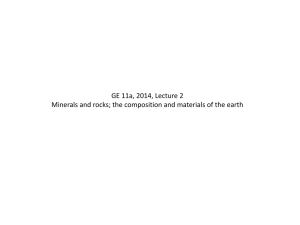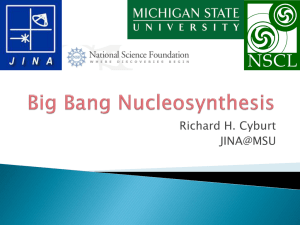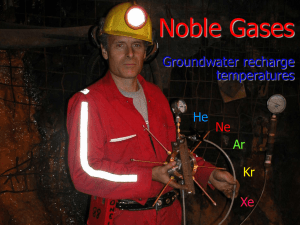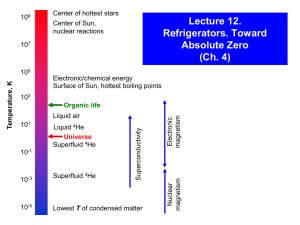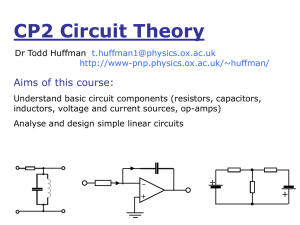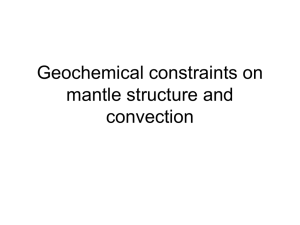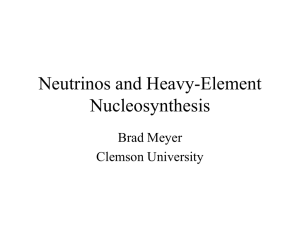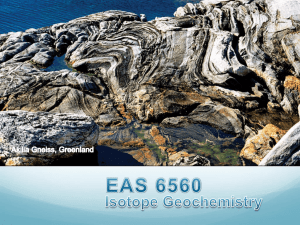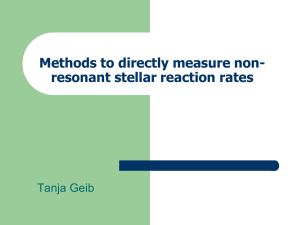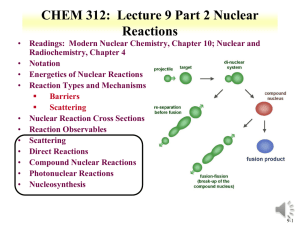Adiabatic hyperspherical study of triatomic helium systems
advertisement
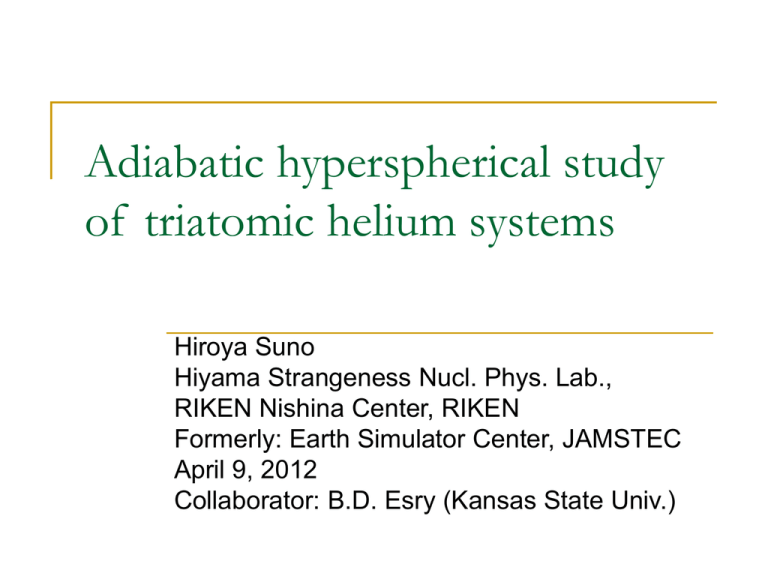
Adiabatic hyperspherical study of triatomic helium systems Hiroya Suno Hiyama Strangeness Nucl. Phys. Lab., RIKEN Nishina Center, RIKEN Formerly: Earth Simulator Center, JAMSTEC April 9, 2012 Collaborator: B.D. Esry (Kansas State Univ.) Triatomic helium systems 4He 4He 4He 4He 4He 3He Weakly bound systems: binding energy about mK≈100neV. 4He is one of the candidates for seeing “Efimov states”, since 3 4He has a large scattering length ~200x(Bohr radius). 2 Theoretical treatment is simple since there exists only one dimer state for 4He. Experimentally, the 4He dimer was observed by Luo et al. and Schöllkopf and Toennies, but Schöllkopf and Toennies could also see the trimer and tetramer. What’s an “Efimov state”? An INFINITY of three-body bound states appear when the two-body scattering length is large compared to the range of the two-body interaction; a12>>r0. This occurs even when no bound state exists for the two-body subsystems. The theory formulated in 1970, but experimentally confirmed only in 2006 in an ultracold gas of 133Cs. In fact, the evidence of Efimov physics was seen measuring the three-body recombination rates. Three-body recombination Important loss mechanism for Bose-Einstein condensates. Collision energies Ultracold: 1μK≈100peV Cold: 1mK≈100neV This work Study the triatomic helium system 4He-4He-4He. Bound-state spectrum Cold three-body recombination Cold atom-dimer elastic scattering Adopt the current state-of-art interaction potential, including retardation and the three-body term developed by Jeziorska et al. and Cencek et al. We consider the states with total angular momenta from J=0 to 7. In addition, we treat the 4He-4He-3He system. We use the adiabatic hyperspherical representation. Computational method Smith-Whitten’s hyperspherical coordinates Adiabatic expansion method Three-particle system discribed by six coordinates (one hyperradius, five hyperangles) Simple to impose the permutation symmetry of identical particles First solve the angular part to obtain the adiabatic potential curves and channel functions Then solve the hyperradial coupled Eqs. R-matrix method Extract the scattering S-matrix from the coupled Eqs. Atomic units •In atomic and molecular physics community, one mostly uses the atomic units for numerical calculations. Atomic unit of length (Bohr radius): Atomic unit of length (electron mass): Atomic unit of energy (Hartree): Smith-Whitten hyperspherical coordinates Hyperradius Hyperangles Euler angles Schrödinger equation •Squared “Grand angular momentum operator” •Interaction potential: Interaction potential where with Interaction potential Use the helium dimer potential of Jezorska et al. We can also include retardation effect. 4He 2 Retarded pot.: E00=1.564mK, a12=91.81Å. Unretarded pot. :E00=1.728mK, a12=87.53Å No bound state for 4He3He or 3He . 2 Use the three-body term of Cencek et al. 4He 2 Potential energy surface at R=15 a.u. 4He-4He-4He 4He-4He-3He Adiabatic expansion method •Solve the adiabatic equation (R-fixed Schrödinger Eq.): •The total wave function is expanded •Obtain the coupled-radial equation: Nonadiabatic couplings given by Permutation symmetry •Expand the channel function on Wigner D functions •Use a direct product of basis splines for •If all the three particles are identical bosons, we impose the boundary conditions: •If two particles are identical bosons, we impose the boundary conditions: Adiabatic hyperspherical potential curves for J=0 •The lowest potential curve corresponds to the atom-dimer channel: •The other higher channels correspond to the three-body continuum states: Adiabatic hyperspherical potential curves for J=0 Similarly interpreted as those for 4He3. By symmetry requirement, the atom-dimer channel exists only for the parity-favored cases: Π=(-1)J. We have calculated the potential curves for JΠ=1,2+,... Bound state energies We have found two bound states for 4He (JΠ=0+), one bound states for 4He 3He 3 2 (JΠ=0+), and none for J>0. 4He (JΠ=0+): E =-130.86mK, E =-2.5882mK. 3 0 1 Hiyama&Kamimura obtained E0=-131.84mK, E1=2.6502mK using the PCKLJS potential. 4He23He(JΠ=0+): E0=-16.237mK. Retardation (~+3%)is found to be more important than the three-body term (~-0.3%). Wave functions for ground and excited states of 4He3(JΠ=0+) Three-body recombination rates •Three-body recombination rate for 4He+4He+4He→4He2+4He: Hyperradial wave number: Scattering matrix element: •Three-body recombination rate for 4He+4He+3He→4He2+3He: Three-body recombination rates for 4He+4He+4He→4He +4He 2 E (mK) •Threshold law: at ultracold collision energies, Three-body recombination rates for 4He+4He+3He→4He +3He 2 •Threshold law: at ultracold collision energies, Collision induced dissociation rates •Collision induced dissociation rate for 4He2+4,3He →4He+4He+4,3He : where Collision induced dissociation rates for 4He +4He→4He+4He+4He 2 E (mK) •Threshold law: at ultracold collision energies, Collision induced dissociation rates for 4He +3He→4He+4He+3He 2 Atom-dimer elastic scattering •Elastic cross section for 4He2+4,3He →4He2+4,3He : where Elastic scattering cross sections for 4He +4He →4He +4He 2 2 E-E00 (mK) Elastic scattering cross sections for 4He +3He →4He +3He 2 2 Summary Studied triatomic helium systems using the adiabatic hyperspherical representation. Adopted the most realistic helium interaction potential, including two-body retardation corrections and a three-body contribution. Three-body term plays only a minor role, while the effects of retardation significant. Subsequently, we have studied the 4He2X systems with X being an alkali-metal atom. Future work: reproduce these results using the Gaussian Expansion Method (GEM). 4He-4He-7Li and 4He-4He-23Na
